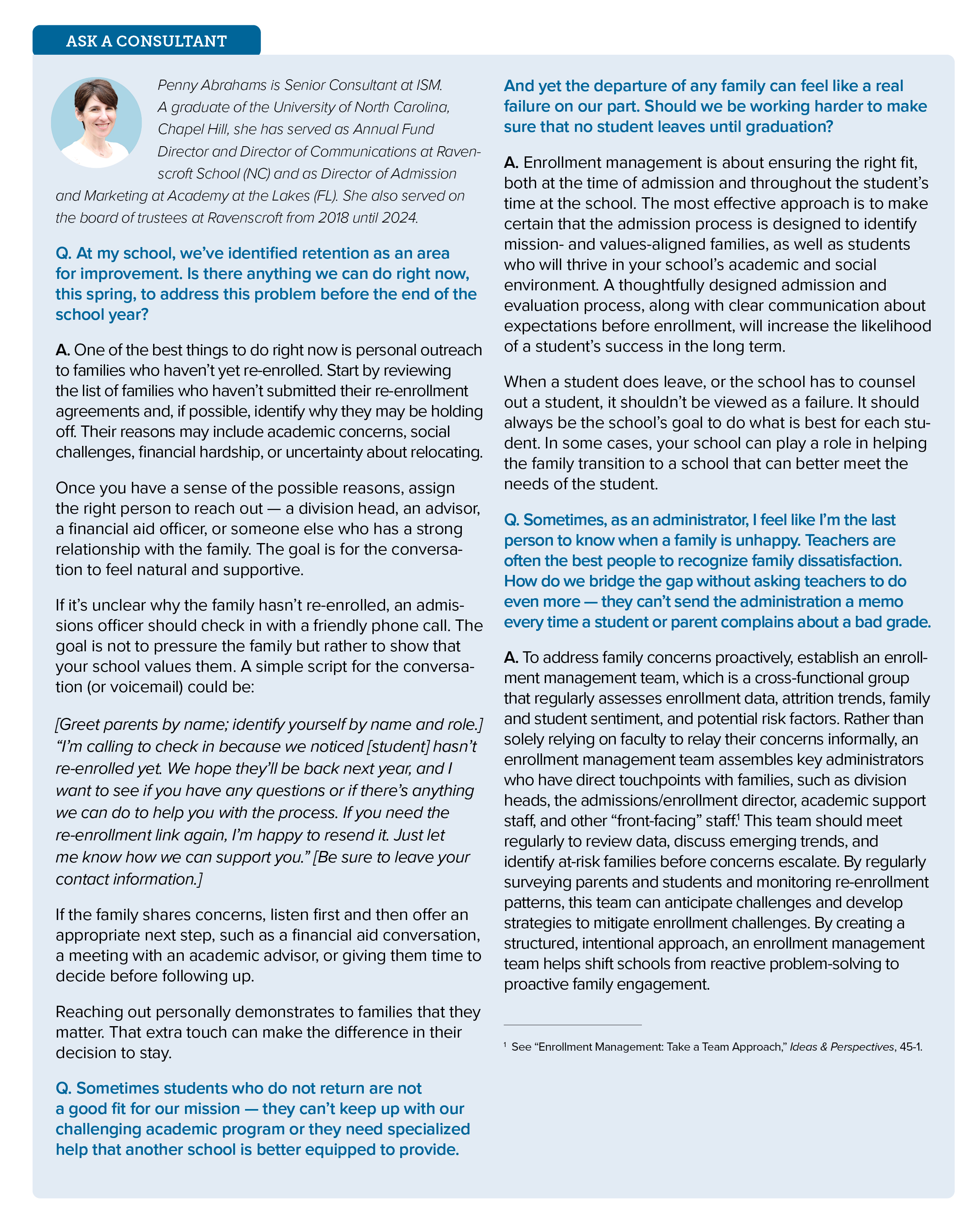

Volume 50 No. 3 ● March 1, 2025 ● Member Sneak Peek
When a school faces stagnant or declining enrollment, administrators and boards often look outward for explanations. Shifting demographics, competing schools with state-of-the-art facilities, and local or national economic trends — all these seem like plausible reasons for enrollment problems. And while these external factors may contribute to a school’s enrollment stagnation, they rarely tell the whole story.
Schools experiencing enrollment declines should ask how to bring in more students. But they must also ask why families are leaving and what they can do to strengthen their relationships with current students and parents.
Too often, schools search for solutions in census data, competitor analyses, and marketing trends before taking a hard look at their own campus culture, academic outcomes, and value proposition. However, enrollment stability and growth start from within. Schools that successfully attract and retain mission-aligned families recognize that enrollment isn’t just a function of external conditions but also a reflection of the student and family experience.
The power of word-of-mouth — for better and worse
Despite the rise of digital marketing, social media, and hypertargeted recruitment strategies, one truth has remained constant over the decades: Word-of-mouth is the most powerful driver of enrollment for private-independent schools. Families overwhelmingly choose schools based on recommendations from people they trust, including friends, family members, colleagues, and current students.
This means a school’s ability to attract new families is deeply intertwined with how current families, faculty, and students perceive their experience. When a school delivers on its promises, cultivates a thriving culture, and provides clear, compelling outcomes, its community naturally becomes its strongest ambassador. Parents and guardians share positive stories, students invite their friends, and faculty reinforce the mission through their dedicated efforts.
Of course, the opposite is also true. If a school’s culture turns toxic, promised outcomes fail to materialize, or families feel disconnected from the mission, word-of-mouth can become a school’s most significant liability. Negative experiences are shared just as quickly as positive ones. A disengaged parent, a frustrated student, or a burned-out teacher can unintentionally (or intentionally) damage a school’s reputation, making it very difficult to stabilize enrollment.
The key to full enrollment is retention
While schools work hard to attract new families, enrollment health depends just as much — if not more — on retention. It can be tempting to throw money at external marketing tactics to attract new students while overlooking the underlying factors that cause existing families to leave.
Families withdraw for many reasons. More often than not, dissatisfaction stems from unmet expectations rooted in a school’s failure to deliver on the promises made during the admission process. Perhaps a student is struggling and doesn’t feel supported, or a parent perceives a lack of communication from teachers or administrators. Maybe the school has changed in ways that no longer align with the family’s values, or faculty turnover has eroded their confidence in the school’s educational program.
In these moments, families don’t just quietly leave. They talk. They share their frustrations with friends, neighbors, and other prospective parents. Sometimes they turn to school review sites, publicly and anonymously airing their grievances. Moreover, just as a strong reputation can lead to an influx of inquiries, negative opinions about the school can create barriers to enrollment growth, especially when amplified online.
Asking the right questions
To engage in critical self-reflection, consider these questions:
- What are our current families, faculty, and students saying about our school? Are their perceptions reinforcing our strengths, or revealing areas that need urgent attention?
- Are we delivering on our promises to students and families? Do the experiences of students and parents align with the vision we promote and the promises we make in our messaging?
- Do our outcomes clearly demonstrate our value proposition? Are we effectively communicating our features and what we offer? More importantly, are we also communicating why these matter in the lives of students and what outcomes families can expect for their children?
- How are we addressing concerns? Do we have a system for identifying and responding to dissatisfaction before it escalates?
Moving from words to action
Asking the right questions is the first step. Schools must then be prepared to act on what they discover. This might mean conducting constituent satisfaction surveys, organizing parent and student focus groups, analyzing attrition data, or inviting an objective external consultant to assess the school’s strengths and challenges.
It also requires a commitment to ongoing communication. If families feel their concerns are heard, acknowledged, and addressed, they are more likely to remain engaged and invested in the school community. Conversely, they are more likely to disengage and take their tuition dollars elsewhere if they feel dismissed or ignored.
At its core, enrollment is not just about digital marketing strategies, branding, and external market conditions. Healthy enrollment is a reflection of a school’s lived experience. Schools that foster a strong culture, deliver on their mission, and prioritize authentic relationships with families will see the positive impact in their enrollment numbers.
For schools struggling with stagnant or declining enrollment, the most crucial shift may be one of perspective. Instead of starting with external factors, they must first turn inward. The answers they find may not only explain their current challenges but also illuminate the path forward.
